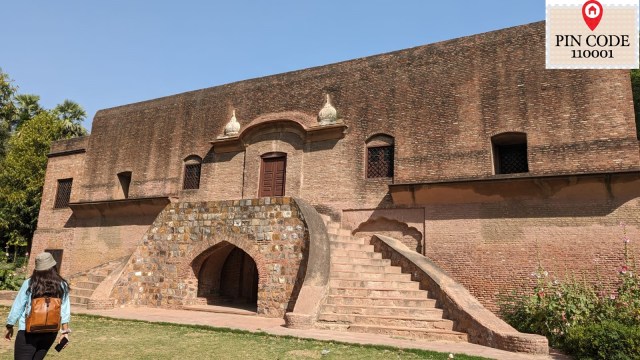Qudsia Bagh: This morning walkers’ paradise was once a symbol of a queen’s ambition, a casualty to 1857 aftermath
Built on a large area, the premises once had, besides a glorious pleasure garden with pavilions (baradari), water channels, and a mosque. The Yamuna flowing nearby provided a perfect backdrop.
 This garden is situated in North Delhi, a short walk from the Kashmere Gate Metro Station. (Express Photo by Deepika Singh)
This garden is situated in North Delhi, a short walk from the Kashmere Gate Metro Station. (Express Photo by Deepika Singh)While the most renowned monuments in Delhi — be it the majestic Humayun’s Tomb or the formidable Red Fort — have been built by powerful men, the city is also home to a few architectural marvels commissioned by prominent women of the Mughal era, signifying the role that they played in the empire.
One of them is Qudsia Bagh. Built by Qudsia Begum, wife of Muhammad Shah Rangeela, who ruled in the early 18th century, the garden is situated in North Delhi, a short walk from the Kashmere Gate Metro Station.
Author and historian Swapna Liddle writes in her book 14 Historic Walks of Delhi, “If you walk along the road going north, along the east of Nicholson Cemetery, across the road you will see a road that leads into a garden. This is Qudsia Bagh, or the ‘garden of Qudsia’.”
Begum, whose original name was Udham Bai, was a dancing girl who went on to marry Rangeela.
Zafar Hasan writes in his book Monuments of Delhi, “She was introduced to Muhammad Shah’s harem in the beginning of his reign… But her good fortune deserted her, she lost all her former influence and station, and eventually was not allowed to see her own son Ahmad Shah.”
However, after the death of Rangeela, Begum’s fortunes turned once again, and she became a powerful woman who was said to have the actual reins of the empire in her hands. “She considered herself the Noor Jehan (wife of Emperor Jahangir) of her times and fashioned herself into a Queen Mother. She remote-controlled the empire since Ahmed Shah was considered a weak king. She sought a legacy and, therefore, like Noor Jehan, wanted to build monuments that would give people something to remember her by. And thus came about the Qudsia Bagh (a pleasure garden) and the Sunehri Masjid, a mosque situated near Red Fort,” said Rameen Khan, Founder of City Tales, which conducts heritage walks and tours.
“Personally, I think it tells us an important fact about Delhi’s landscape, which is that several of Delhi’s gardens were commissioned by women. We don’t often realise that women have shaped this city even in Mughal times,” Liddle told The Indian Express.
Built on a large area, the premises once had, besides a glorious pleasure garden with pavilions (baradari), water channels, and a mosque. The Yamuna flowing nearby provided a perfect backdrop.
But then came 1857. “The buildings in this garden were severely damaged during the summer of 1857 when they fell in the line of fire that was exchanged between the Indian troops who were holding the city, and the British troops who held the high ground on the ridge,” Liddle writes in her book.
“The British cut down the citrus trees in it and constructed batteries on which they put cannons to bombard the city,” she told The Indian Express.
Over a century and a half later, only the gateway, the mosque — which still bears the signs of 1857 in the form of craters in the walls — and parts of the pavilion remain, the latter being modified by the British in the early 20th century. The Yamuna receded with time, taking away whatever aesthetics were still left intact. With its extensive greenery, the Bagh now serves as a morning walk point, with many of its patrons unaware of its history. It was recently given a facelift as part of DDA’s project to revive Yamuna’s floodplains.
For Khan, the ruins too are a part of the charm. “I feel like the fortunes of this place coincided with the fate of its founder, Qudsia Begum. She was a dancing girl who caught the fancy of the king but was then relegated to the position of a secondary queen before her luck favoured her and she became prominent again. Similarly, this place was once beautiful and grand, then fell into ruin, and now has been resurrected again as an oasis of calm in the chaos of modern-day Delhi,” Khan said.












